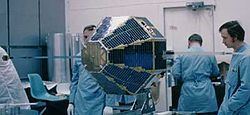Mission type Space Physics COSPAR ID 1974-040A Launch date 3 June 1974 Inclination 89.8° Apogee 125,570 m | SATCAT no. 07325 Inclination 89.8° Period 2.1 days | |
 | ||
Names Neutral Point ExplorerInjun-F07325 Similar Solrad 8, Explorer 49, Heat Capacity, Explorer 9, Explorer 32 | ||
In navigazione sul garcia explorer 52
Explorer 52 was an American satellite launched on June 3, 1974 from Vandenberg Air Force Base on a Scout booster.
Contents
This satellite was also known as:
Mission
The primary mission objective of Hawkeye 1 (Explorer 52) was to conduct particles and fields investigations of the polar magnetosphere of the earth out to 21 earth radii. Secondary objectives were to make magnetic field and plasma distribution measurements in the solar wind, and to study Type-3 radio emissions caused by solar electron streams in the interplanetary medium. To accomplish these objectives, the spacecraft was instrumented with following instruments:
The spacecraft was spin stabilized with a nominal rotational period of 11 s. In celestial coordinates, the positive spin axis coordinates were right ascension 299.4 degrees (plus or minus 1.1 deg) and declination 8.6 deg (plus or minus 1.5 deg). There was no onboard orientation or spin rate control, but the orientation of the spin axis was stable. An optical aspect system operated from launch until September 3, 1974 at which time the optical aspect system was turned off and failed to turn back on. After this period, aspect had to be determined by observing the effect of optical illumination from the sun on a plasma measurement system. Using the sharp peak observed in this data, corrected orientation information was obtained and rewritten to the data records. The complete spacecraft with instruments had a mass of 22.65 kilograms (49.9 lb). Power of 22 to 36 W, depending on solar aspect, was obtained from solar cells. Hawkeye 1 participated in the International Magnetospheric Study (IMS) and during the first half of 1977 data acquisition was confined to IMS special intervals. Data were obtained in real time only, at frequencies of 136 and 400 MHz at 100 bit/s (or 200 bit/s with convolutional coding) plus wideband VLF data.
Specifics
It was designed, built, and tracked by personnel at the Department of Physics and Astronomy, University of Iowa whose sports teams are the Hawkeyes. The spacecraft was launched on June 3, 1974 into a polar orbit with initial apogee over the North Pole and re-entered on April 28, 1978 after 667 orbits or nearly four years of continuous operation. The spacecraft apogee was between 20.28 and 20.92 Earth radii with less than a 1.7 Earth radii perigee. The orbital period was 51.3 hours. During its lifetime, the inclination of the plane of the spacecraft's orbit to the Earth's equator decreased monotonically from 89.81 to 81.85 degrees. The spacecraft's axis of rotation at launch was inertially fixed in its orbital plane, directed towards a constant right ascension and declination, and nearly parallel to the Earth's equatorial plane.
